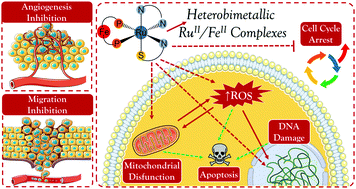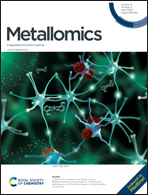Heterobimetallic Ru(ii)/Fe(ii) complexes as potent anticancer agents against breast cancer cells, inducing apoptosis through multiple targets†
Abstract
Antimetastatic activity, high selectivity and cytotoxicity for human tumor cell lines make ruthenium(II) complexes attractive for the development of new chemotherapeutic agents for cancer treatment. In this study, cytotoxic activities and the possible mechanism of cell death induced by three ruthenium complexes were evaluated, [Ru(MIm)(bipy)(dppf)]PF6 (1), [RuCl(Im)(bipy)(dppf)]PF6 (2) and [Ru(tzdt)(bipy)(dppf)]PF6 (3). The results showed high cytotoxicity and selectivity indexes for the human triple-negative breast tumor cell line (MDA-MB-231) with IC50 value and selectivity index for complex 1 (IC50 = 0.33 ± 0.03 μM, SI = 4.48), complex 2 (IC50 = 0.80 ± 0.06 μM, SI = 2.31) and complex 3 (IC50 = 0.48 ± 0.02 μM, SI = 3.87). The mechanism of cell death induced in MDA-MB-231 cells, after treatment with complexes 1–3, indicated apoptosis of the cells as a consequence of the increase in the percentage of cells in the Sub-G1 phase in the cell cycle analysis, characteristic morphological changes and the presence of apoptotic cells labeled with Annexin-V. Multiple targets of action were identified for complexes 1 and 3 with an induction of DNA damage in cells treated with complexes 1 and 3, mitochondrial depolarization with a reduction in mitochondrial membrane potential, an increase in reactive oxygen species levels and increased expression levels of caspase 3 and p53. In addition, antimetastatic activities for complexes 1 and 3 were observed by inhibition of cell migration by the wound healing assay and Boyden chamber assay, as well as inhibition of angiogenesis caused by MDA-MB-231 tumor cells in the CAM model.



 Please wait while we load your content...
Please wait while we load your content...